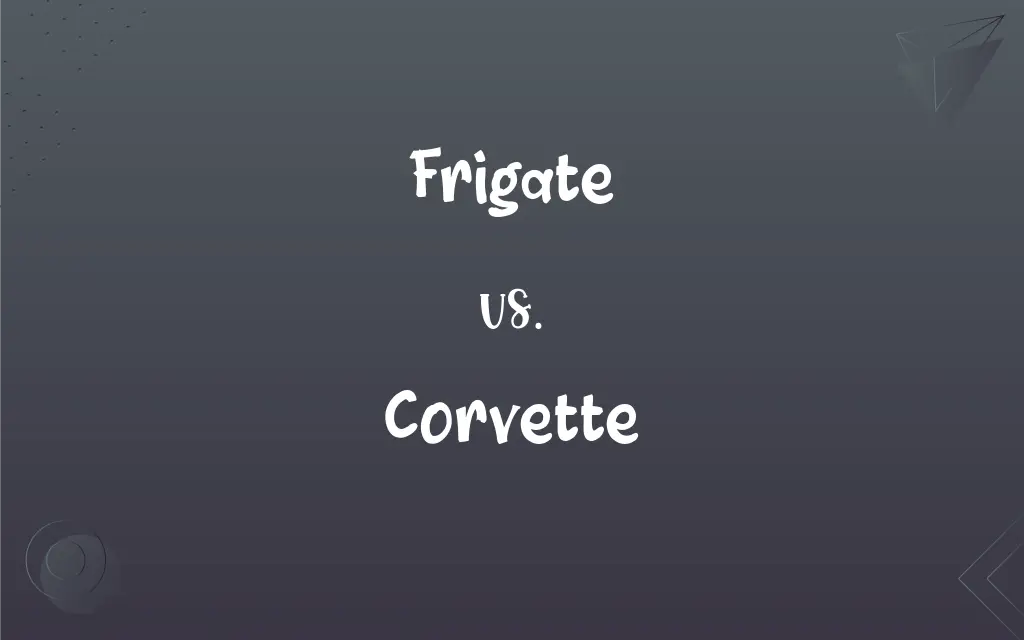Frigate vs. Corvette: What's the Difference?
By Aimie Carlson & Janet White || Updated on March 4, 2024
A frigate is a type of warship that is larger, often designed for open ocean warfare and performing a variety of missions, whereas a corvette is smaller, typically used for coastal defense and patrol duties.

Key Differences
Frigates and corvettes are both classes of warships used by navies around the world, each serving distinct roles based on their size, armament, and capabilities. Frigates are larger vessels that operate in open seas, equipped to engage in warfare against submarines, aircraft, and surface ships. Corvettes, on the other hand, are the smallest class of warships considered to be rated vessels. They are primarily used for coastal patrol and defense, anti-submarine warfare, and sometimes mine-sweeping operations.
The decision to deploy frigates or corvettes depends on the mission's specific requirements. Frigates are better suited for blue-water (open ocean) operations where endurance, versatility, and the ability to project power are necessary. In contrast, corvettes are more often utilized in green-water (coastal) and brown-water (riverine or near-shore) operations, where their capabilities are well-suited to the environment and mission scope.
In terms of hierarchy and naval strategy, frigates are typically part of larger task forces or flotillas, serving as the principal combatants in many navies, while corvettes operate either independently or in support of larger vessels, providing localized patrol and escort services. The distinction between frigates and corvettes is not just a matter of size but reflects their intended tactical and strategic use in modern naval operations.
Comparison Chart
Size & Displacement
Larger, with greater displacement.
Smaller, with less displacement.
Primary Role
Multi-role; open ocean warfare and missions.
Coastal defense and patrol.
ADVERTISEMENT
Weaponry
Heavily armed with a wide range of weapons.
Less heavily armed, but still formidable.
Operations
Blue-water (open ocean) operations.
Green-water (coastal) and brown-water (near-shore) operations.
Versatility
High; capable of performing a variety of missions.
Limited by size, but agile and efficient in designated roles.
Frigate and Corvette Definitions
Frigate
Equipped for anti-submarine, anti-air, and surface combat.
The frigate's advanced sonar systems are crucial for anti-submarine operations.
Corvette
Operates independently or in small groups.
A pair of corvettes patrolled the strategic strait.
ADVERTISEMENT
Frigate
A versatile warship designed for open sea warfare.
The navy dispatched a frigate to patrol the international waters.
Corvette
A small, fast warship designed for coastal patrol and defense.
Corvettes are often deployed for coastal surveillance missions.
Frigate
Integral to naval task forces.
Frigates serve as the backbone of the naval expeditionary force.
Corvette
Specializes in anti-submarine warfare in littoral zones.
The corvette's shallow draft allows it to operate effectively in coastal waters.
Frigate
Features advanced detection and electronic warfare systems.
The frigate's radar systems enable it to track and engage multiple threats simultaneously.
Corvette
Agile and maneuverable.
The corvette quickly responded to the emergency call near the coast.
Frigate
A warship that is smaller than a destroyer and used primarily for escort duty.
Corvette
Equipped with a compact but potent array of weapons.
Despite its size, the corvette carries anti-ship missiles and torpedoes.
Frigate
A high-speed, medium-sized sailing war vessel of the 1600s, 1700s, and 1800s.
Corvette
A fast, lightly armed warship, smaller than a destroyer, often armed for antisubmarine operations.
Frigate
(Obsolete) A fast, light vessel, such as a sailboat.
Corvette
An obsolete sailing warship, smaller than a frigate, usually armed with one tier of guns.
Frigate
(nautical) Any of several types of warship:
Corvette
A flush-decked warship of the 17th-18th centuries having a single tier of guns; it ranked next below a frigate; – called in the United States navy a sloop of war.
Frigate
(historical) A sailing warship (of any size) built for speed and maneuverability; typically without raised upperworks, having a flush forecastle and tumblehome sides.
Corvette
(nautical) In a modern navy, a lightly armed and armoured blue water warship, smaller than a frigate, capable of transoceanic duty.
Frigate
(historical) A sailing warship with a single continuous gun deck, typically used for patrolling and blockading duties, but not considered large enough for the line of battle.
Corvette
A highly maneuverable escort warship; smaller than a destroyer
Frigate
(historical) A warship combining sail and steam propulsion, typically of ironclad timber construction, supplementing and superseding sailing ships of the line at the beginning of the development of the ironclad battleship.
Frigate
(historical) A escort warship, smaller than a destroyer, introduced in World War 2 as an anti-submarine vessel.
Frigate
A modern type of warship, equivalent in size or smaller than a destroyer, often focused on anti-submarine warfare, but sometimes general purpose.
Frigate
(fictional) A warship or space warship, inspired by one of the many historic varieties of frigate.
Frigate
A frigatebird (Fregata spp.).
Frigate
Originally, a vessel of the Mediterranean propelled by sails and by oars. The French, about 1650, transferred the name to larger vessels, and by 1750 it had been appropriated for a class of war vessels intermediate between corvettes and ships of the line. Frigates, from about 1750 to 1850, had one full battery deck and, often, a spar deck with a lighter battery. They carried sometimes as many as fifty guns. After the application of steam to navigation steam frigates of largely increased size and power were built, and formed the main part of the navies of the world till about 1870, when the introduction of ironclads superseded them.
Frigate
Any small vessel on the water.
Frigate
A medium size square-rigged warship of the 18th and 19th centuries
Frigate
A United States warship larger than a destroyer and smaller than a cruiser
Frigate
Capable of long-duration missions.
Frigates often undertake months-long deployments without needing to resupply.
FAQs
Are there any modern naval forces that use both frigates and corvettes?
Yes, many modern navies around the world maintain both frigates and corvettes in their fleets to fulfill a variety of operational roles and requirements.
How do navies decide between using a frigate or a corvette?
The decision is based on the mission's specific requirements, including the operational environment, desired capabilities, and strategic objectives.
How has the role of frigates and corvettes evolved over time?
The roles of frigates and corvettes have evolved with advancements in technology and changes in naval warfare strategies, with both classes now featuring more sophisticated weapons and systems for diverse missions.
Can frigates and corvettes operate under international coalitions?
Yes, frigates and corvettes often operate under international coalitions, contributing to multinational maritime security efforts, exercises, and missions, enhancing interoperability and collective defense capabilities.
How do frigates and corvettes contribute to a navy's overall strategic capabilities?
Frigates enhance a navy's blue-water operational capabilities, while corvettes bolster coastal defense and patrol capabilities, together providing a balanced force capable of addressing a wide range of maritime threats.
Why are frigates considered more versatile than corvettes?
Frigates are designed for a wide range of missions in open ocean scenarios, making them more versatile due to their larger size, greater endurance, and broader array of weapons and systems.
Can corvettes participate in open ocean operations like frigates?
While corvettes can operate in open waters, their smaller size and limited endurance make them less suitable for prolonged blue-water operations compared to frigates.
Do frigates and corvettes have helicopter capabilities?
Many modern frigates are equipped with helicopter decks and hangars for anti-submarine and search-and-rescue operations, while corvettes may have limited or no helicopter capabilities due to size constraints.
What impact does the cost have on a navy's decision to commission frigates or corvettes?
Cost considerations, including construction, maintenance, and operational expenses, play a significant role, with corvettes generally being less expensive to build and operate than frigates.
What technological advancements have most impacted frigates and corvettes in recent years?
Technological advancements such as stealth design, advanced missile systems, and enhanced electronic warfare capabilities have significantly impacted both frigates and corvettes, improving their effectiveness in modern naval operations.
How does crew size differ between frigates and corvettes?
Frigates typically have a larger crew to manage the ship's more complex systems and longer missions, whereas corvettes, being smaller, require fewer personnel.
What is the role of unmanned systems on frigates and corvettes?
Unmanned aerial, surface, and underwater systems are increasingly integrated into frigates and corvettes for reconnaissance, mine detection, and combat support, expanding their operational capabilities without risking crew lives.
What are the key differences in radar and sonar capabilities between frigates and corvettes?
Frigates typically have more advanced radar and sonar systems due to their larger size and broader mission scope, enabling long-range detection and tracking, while corvettes have more compact systems optimized for littoral environments.
What is the significance of agility in corvettes' design?
Agility allows corvettes to maneuver in confined or shallow waters, making them particularly effective for operations close to shore and in littoral zones.
What challenges do navies face in maintaining and upgrading frigates and corvettes?
Challenges include the high costs of maintenance and upgrades, integrating new technologies with existing systems, and ensuring the vessels remain combat-ready and capable of fulfilling future operational requirements.
What future trends are expected in the development of frigates and corvettes?
Future trends include the increased use of automation and artificial intelligence, further integration of unmanned systems, enhanced stealth features, and a focus on modular design to allow rapid reconfiguration for different mission needs.
How do frigates and corvettes support anti-piracy operations?
Frigates and corvettes are deployed in anti-piracy operations to patrol high-risk areas, escort commercial vessels, and intervene in piracy incidents, leveraging their speed, firepower, and surveillance capabilities.
How do environmental considerations affect the design and operation of frigates and corvettes?
Environmental considerations, including emissions control, waste management, and the use of environmentally friendly materials, are increasingly influencing the design and operation of frigates and corvettes to minimize their ecological impact.
How do frigates and corvettes contribute to humanitarian missions?
Frigates and corvettes contribute to humanitarian missions by providing disaster relief, medical assistance, and logistical support in crisis situations, utilizing their mobility and onboard resources to aid affected communities.
How do the armament configurations of frigates and corvettes differ?
Armament configurations differ with frigates equipped for a wider range of combat scenarios, including anti-air, anti-surface, and anti-submarine warfare, while corvettes carry a more focused armament suited to their primary missions like coastal patrol and anti-submarine efforts.
About Author
Written by
Aimie CarlsonAimie Carlson, holding a master's degree in English literature, is a fervent English language enthusiast. She lends her writing talents to Difference Wiki, a prominent website that specializes in comparisons, offering readers insightful analyses that both captivate and inform.
Co-written by
Janet WhiteJanet White has been an esteemed writer and blogger for Difference Wiki. Holding a Master's degree in Science and Medical Journalism from the prestigious Boston University, she has consistently demonstrated her expertise and passion for her field. When she's not immersed in her work, Janet relishes her time exercising, delving into a good book, and cherishing moments with friends and family.
































































